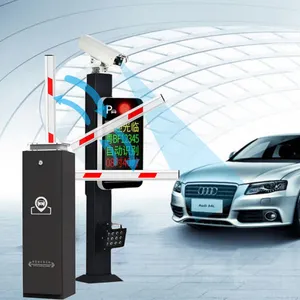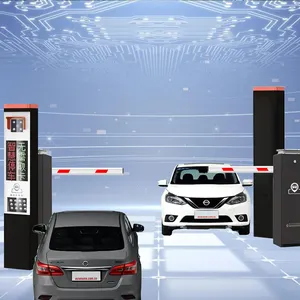
All categories
Featured selections
Trade Assurance
Buyer Central
Help Center
Get the app
Become a supplier

(91 products available)




















































There are many different types of car park system parking entrance gates available, and they include the following:
Automatic Barrier Gates
Automatic barrier gates comprise a horizontal arm that automatically opens and closes. They are important for managing vehicle access and controlling traffic at parking lots, toll booths, and restricted areas. These gates also enhance security by restricting unauthorized access. In addition, they are essential at places with high traffic volumes since they reduce wait times and improve overall operational efficiency.
Security Turnstiles
Security turnstiles are gates that provide controlled access in places like parking lots, public transport stations, and building entrances. Security turnstiles are also important in enhancing security since they prevent tailgating and unauthorized access. They also come in different designs such as revolving and optical turnstiles to meet various security requirements.
Parking Kiosks
Parking kiosks are automated terminals installed at parking lots to facilitate payment processing and ticketing services. They are essential since they reduce the need for attendants, thus lowering operational costs. Parking kiosks are also important in enhancing contactless transactions through mobile payments or QR code scanning, improving overall hygiene and safety. They also enhance accessibility for disabled persons by providing alternative payment options and assistance requests.
Parking Lot Gate
Parking lot gates are installed at entrances and exits to parking lots. They provide access control and security, thus preventing unauthorized access. They are important at places like shopping centers, residential areas, and events venues where managing vehicle entry and exit is important. In addition to enhancing security, parking lot gates control traffic flow, especially in busy areas, thus reducing congestion.
Parking Barriers
Parking barriers are gates used to control access and manage traffic in parking areas. They come in different types such as automatic and manual barriers to suit various parking system requirements. Besides, parking barriers enhance security by preventing unauthorized access to restricted areas. Some parking barriers also have integrated systems such as ticket dispensers or payment terminals, thus improving convenience and operational efficiency.
The specifications of parking entrance gates vary depending on the manufacturer and model. Here are some common specifications that can be used in general:
Regular maintenance of parking entrance gates is essential to ensure their proper operation and durability. The following are general maintenance requirements:
Choosing the right car parking system for a business can be a daunting task. Here are some tips to help make the decision easier:
Business Needs
Understand the business's needs before anything else. Consider how many cars the parking lot can hold and how many are expected daily. For instance, a busy mall will need a different system than a small office.
Type of Parking System
There are several parking lot entrance gate systems, each with its pros and cons. Some gates control access to the entrance, while others provide ticketing and payment options. Research the different types and see which fits the business better.
Security
The parking system should offer security for both the cars and the people. Look for features like CCTV cameras, well-lit areas, and trained staff to monitor the parking lot. Also, consider the system's security features, such as access control and anti-theft measures.
Cost
Of course, the parking system will have a budget. Find a system that offers the best value for money. Sometimes, spending a little more can save costs in the long run through increased efficiency and security.
Technology
In this digital age, technology is essential in making everything run smoothly. Look for systems with automated gates, payment machines, and parking space indicators. These can enhance the parking experience for everyone. Also, consider systems that integrate with existing technology, such as mobile payment apps or license plate recognition.
Installation and Maintenance
Consider the installation and maintenance requirements of the chosen parking system. Some systems may require extensive construction or electrical work, while others are more straightforward to install. Additionally, consider the long-term maintenance needs of the system, such as regular servicing or replacement parts.
Scalability
If the business plans to expand or change in the future, choose a parking system that can adapt to growth. This will save costs and headaches in the long run.
Environmental Considerations
With the growing concern for the environment, consider the environmental impact of the parking system. Look for systems that promote sustainable practices, such as energy-efficient lighting or electric vehicle charging stations.
Feedback and Reviews
Finally, seek feedback from other businesses using the same parking system. Their experience can provide valuable insight and help make an informed decision.
It is important to note that different parking entrance gates have different installation processes. The installation process may vary depending on the type of gate, model, and size. Always follow the manufacturer's instructions. Here are some general steps for installing a car park system parking entrance gate:
It is as important as installing a parking entrance gate to replace it when damaged or worn out. The process is quite similar to installing a new parking entrance gate. Here are some general steps for replacing a parking entrance gate:
Always consult a professional when installing or replacing a parking entrance gate to ensure it is done correctly and safely.
Q1. How does a car parking system work?
A1. The system is designed to maximize space and minimize the use of space. The system consists of a parking entrance gate and a parking exit gate. Both gates have access control devices, and the entrance gate has a license plate recognition device that recognizes vehicles entering the parking lot and records their information. It also has a ticketing machine that dispenses tickets for vehicles that do not have a reservation or are not recognized by the system. Other devices at the entrance include access control for membership vehicles, a barrier gate that prevents unauthorized exit or entry, and a safety loop that detects vehicles at the gate to prevent accidents. The parking lot also has a parking management system that ensures all vehicles are accounted for and manages the reservation system. Overall, the parking system works by utilizing technology and management systems to ensure efficient parking space utilization while ensuring safety and security.
Q2. What is the purpose of the parking system?
A2. The parking system manages parking space by controlling access to the parking lot. It does this by utilizing a parking entrance system that consists of various access control devices such as barriers, license plate recognition systems, ticketing machines, and safety loops. This ensures that only authorized vehicles enter and exit the parking lot, enhancing security. Additionally, it ensures efficient parking management by accounting for all vehicles in the parking lot through a parking management system and managing reservations. By doing this, the parking system ensures optimal use of available parking space.
Q3. Where is the car parking system used?
A3. The car parking system is used in various places, such as shopping malls, airports, residential areas, hospitals, and other public places. Basically, anywhere there is a need to manage parking space and access control to enhance security and efficiency.
Q4. What are the benefits of a parking system?
A4. The parking system has several advantages, such as maximizing the use of available parking space, improving security by controlling access to the parking lot, and increasing operational efficiency by managing reservations and accounting for all vehicles in the parking lot. This ensures that the parking system meets the needs of the parking lot.
Q5. What is a smart parking system?
A5. Smart parking is a system that uses modern technology such as IoT (Internet of Things) to enhance parking management. It provides real-time information about parking space availability, facilitates online reservations, and automates payment processing, thereby improving parking efficiency and convenience.